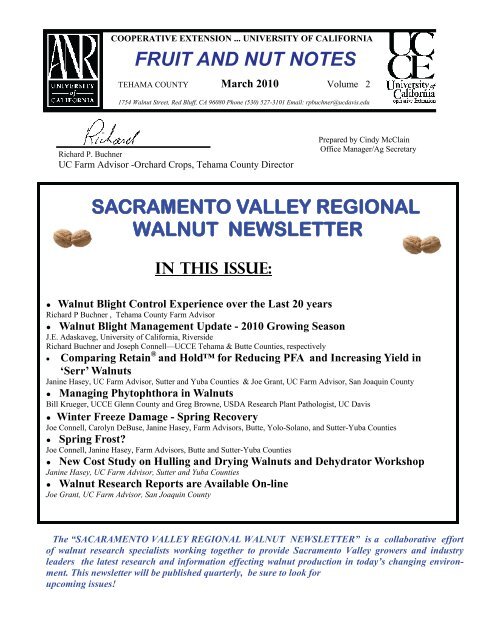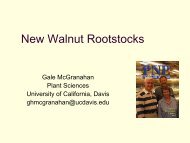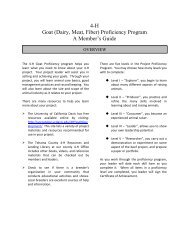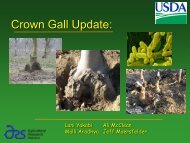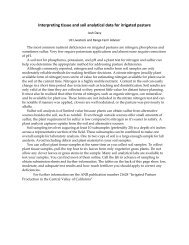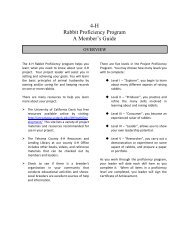Download Newsletter - Tehama County
Download Newsletter - Tehama County
Download Newsletter - Tehama County
Create successful ePaper yourself
Turn your PDF publications into a flip-book with our unique Google optimized e-Paper software.
COOPERATIVE EXTENSION ... UNIVERSITY OF CALIFORNIAFRUIT AND NUT NOTESTEHAMA COUNTY March 2010 Volume 21754 Walnut Street, Red Bluff, CA 96080 Phone (530) 527-3101 Email: rpbuchner@ucdavis.eduRichard P. BuchnerUC Farm Advisor -Orchard Crops, <strong>Tehama</strong> <strong>County</strong> DirectorPrepared by Cindy McClainOffice Manager/Ag SecretarySACRAMENTO VALLEY REGIONALWALNUT NEWSLETTERIN THIS ISSUE:● Walnut Blight Control Experience over the Last 20 yearsRichard P Buchner , <strong>Tehama</strong> <strong>County</strong> Farm Advisor● Walnut Blight Management Update - 2010 Growing SeasonJ.E. Adaskaveg, University of California, RiversideRichard Buchner and Joseph Connell—UCCE <strong>Tehama</strong> & Butte Counties, respectively• Comparing Retain ® and Hold for Reducing PFA and Increasing Yield in‘Serr’ WalnutsJanine Hasey, UC Farm Advisor, Sutter and Yuba Counties & Joe Grant, UC Farm Advisor, San Joaquin <strong>County</strong>● Managing Phytophthora in WalnutsBill Krueger, UCCE Glenn <strong>County</strong> and Greg Browne, USDA Research Plant Pathologist, UC Davis● Winter Freeze Damage - Spring RecoveryJoe Connell, Carolyn DeBuse, Janine Hasey, Farm Advisors, Butte, Yolo-Solano, and Sutter-Yuba Counties● Spring Frost?Joe Connell, Janine Hasey, Farm Advisors, Butte and Sutter-Yuba Counties● New Cost Study on Hulling and Drying Walnuts and Dehydrator WorkshopJanine Hasey, UC Farm Advisor, Sutter and Yuba Counties● Walnut Research Reports are Available On-lineJoe Grant, UC Farm Advisor, San Joaquin <strong>County</strong>The “SACARAMENTO VALLEY REGIONAL WALNUT NEWSLETTER” is a collaborative effortof walnut research specialists working together to provide Sacramento Valley growers and industryleaders the latest research and information effecting walnut production in today’s changing environment.This newsletter will be published quarterly, be sure to look forupcoming issues!
Walnut Blight Control Experience over the Last 20 yearsRichard P. Buchner, <strong>Tehama</strong> <strong>County</strong> Farm Advisor1) Complete walnut blight research information is available at the UC Fruit and Nut informationcenter http://walnutresearch.ucdavis.edu2) Consider First blight application when 40 percent of the pistillate buds have expanded to the“prayer stage”.3) Copper tank mixed with a section 18 ethylene bis-dithiocarbamate (EBDC) product is currently themost effective spray choice. For 2010, the two available EBDC products are DuPont Manzateflowable or Manzate Pro-Stick. Be aware of application issues if a time limited tolerance is not issuedby the US EPA.Tollerance information changes quickly so check with your walnut buyer beforeapplication.4) Full coverage at full material rates is suggested. Under severe walnut blight infection pressure,excellent coverage at the correct application rate is advised.5) Good quality copper products are all effective for controlling walnut blight. Follow label ratesbecause metallic rates and copper availability vary depending upon the manufacturer.6) Following the first application, consider damage history and weather forecasts for additional spraydecisions. Sprays are thought to provide protection for 7 to 10 days.7) Computer weather forecasts (http://www.noaa.gov/) and or Xanthocast (Irrigate.net orAgtelemetry.com) are available. Weather channels forecast weather conditions and Xanthocastdeveloped By Dr. Jim Adaskaveg at UC Riverside can help determine disease infection events.Prayer Stage
Walnut Blight Management Update - 2010 Growing SeasonJ. E. Adaskaveg, University of California, Riverside, R. Buchner, and J. Connell, UCCE, <strong>Tehama</strong> and Butte Co., respectivelyWalnut blight is caused by the bacterium Xanthomonas arboricola. Copper was the sole material available formanaging this devastating leaf and fruit disease since the inception of modern walnut production in California.In the early 1990s, copper resistance developed in the pathogen populations and the disease began causing significantcrop losses in many orchards in the central and northern production areas of the state. Research at the University ofCalifornia (UC) showed that the disease could still be managed when copper was mixed with an ethylene bisdithiocarbamateor EBDC fungicide such as maneb (e.g., Manex-DuPont Crop Protection). Since the early 1990s, theCalifornia Walnut Commission has successfully petitioned the United States Environmental Protection Agency (US-EPA) for an emergency registration of Manex® (one of the longest standing Section 18s in the history of USagriculture). While the EPA was concurrently reviewing the registration of the entire class of EBDC pesticides, theCalifornia Walnut Board aggressively funded UC research to better understand the epidemiology of the disease andmanagement practices including alternative treatments for Manex®.In 2009, as part of a joint decision between the US-EPA and the EBDC task force (a coalition of registrants andmanufacturers of EBDC products), the United States registration of maneb, which is used to manufacture Manex®,was canceled. Fortunately, UC research has identified several alternative products ranging from fungicides, anantibiotic, and organic compounds. A closely related EBDC compound, mancozeb, was identified that could be a“drop in” replacement for maneb. With over 18 years of experience with copper and EBDC materials for managingwalnut blight, mancozeb was the logical choice for pursuing an emergency registration for commercially managingblight. The California walnut industry has successfully petitioned the US-EPA for an emergency registration ofmancozeb and the California Department of Pesticide Regulation has issued a Section 18 Exemption on February 25,2010 to allow applications of DuPont Manzate Flowable or Manzate Pro-Stick in combination with copper onwalnut in selected California Counties. Either product must be tank mixed with a fixed copper product registered foruse on walnut in California. The US EPA has not established a time limited tolerance but expects to do so in the nearfuture. If residues are found on walnut at the time of harvestand a tolerance has not been issued, the residue levels will be considered illegal. Both Manzate formulations are verysimilar to Manex® however they are coordinated EBDC, i.e., a defined mixture of zinc and manganese is used in themanufacturing of the active ingredient (Zn- and Mn-EBDC). This fungicide/bactericide has been registered in theUnited States for over 50 years and provides broad-spectrum disease control. Both Manzate Pro-Stick and ManzateFlowable, when tank mixed with copper, are highly effective for managing bacterial plant diseases. Table 1 comparesthe properties of Manex® and Manzate Pro Stick. Note that Manex® is no longer legal to apply on California walnut.In summary, Manzate Pro-Stick plus copper or Manzate flowable plus copper have been shown to be equivalent to Manex®plus copper for managing walnut blight (Fig. 1). Over the last four years, more than 20 research trials have been conducted in<strong>Tehama</strong>, Butte, Solano and Fresno Counties evaluating Manzate Pro-Stick, Manzate Flowable other mancozeb products, andalternative treatments.
Comparing Retain ® and Hold for Reducing PFAAnd Increasing Yield in ‘Serr’ WalnutsJanine Hasey, UC Farm Advisor, Sutter and Yuba Counties & Joe Grant, UC Farm Advisor, San Joaquin <strong>County</strong>Over many years of testing, ReTain ® (Valent BioSciences Corp.) has been shown to effectively reduce pistillateflower abscission(PFA) and increase nut set and yield in ‘Serr’ and other walnut varieties in the San JoaquinValley. Local ReTain ® trials attempted in 2006 and 2008 experienced rain and frost respectively that precludeda fair assessment. More recently, studies of bloom treatments using HOLD (StollerUSA) which is acombination of two nutrient supplements ReZist and Calcium 5S had shown promise in increasing walnutset and yield in some trials. Although less expensive than ReTain ® , the efficacy of HOLD had not beenwell documented, especially in “side-by-side” comparisons with ReTain ® . Trials were conducted in 2009 tofurther evaluate HOLD for its ability to improve set and yield in ‘Serr’ walnuts when compared directly toReTain ® in both the Sacramento and San Joaquin Valleys.Trials were conducted in mature ‘Serr’ orchards, one in San Joaquin <strong>County</strong> and one in Sutter <strong>County</strong>. Experimentaldesign, spray applications, and data gathering methods varied slightly between the two sites (Table 1)but the three treatments were the same:1. ReTain ® , 1 pouch (333 grams) per acre2. HOLD (ReZist, 2 qt/a plus Calcium 5S, 2 qt/a, packaged separately)3. UntreatedWe measured nut set by tagging 20 to 30 mid-canopy receptive double-flowered spurs on each of two trees intreated and untreated blocks. Tagging was done within one or two days before or after spray applications ateach site. The number of nutlets per tagged spur was determined three to four weeks after treatment to assessPFA and again eight to nine weeks after treatment to assess nut drop from non-pollination and other post-PFAcauses. Sub-samples of field harvested nuts were collected, hulled and dehydrated to determine yield on a dryin-shell weight basis from field harvest weights.At both sites, there was considerable overlap between Serr pistillate bloom and pollen shedding; thus the potentialfor a heavy pollen load and PFA was great.ReTain ® significantly reduced PFA at both sites (a four fold decrease at the Sutter <strong>County</strong> site), as measuredby four-week post-treatment set counts (Figure 1). HOLD treatments did not significantly increase nut set ateither site. There was very little nut drop between the first and second set counts at both sites. This later dropis assumed to be due to non-pollination or other causes indicating that most of the drop at both sites wascaused by PFA. ReTain ® also significantly increased yield at both sites (yield doubled at the Sutter <strong>County</strong>site). HOLD treatment yields did not significantly differ from the untreated trees.At the Sutter <strong>County</strong> site, nut quality grading by Diamond Foods, Inc. showed no significant differences in nutsize or internal quality among treatments. This same nut quality result was found comparing these three treatmentsin the 2008 trial on ‘Tulare’ in Yuba <strong>County</strong>.The economic value of ReTain ® applications is entirely dependent upon flower density, the PFA level withinthe orchard, and the percent orchard acreage affected by PFA. ReTain ® is not a cure-all for poor orchard performanceassociated with other factors that reduce flower number (the critical component for high yields),such as poor water management or excessive shade. Each grower has to determine if it’s economical for themto use ReTain ® in a given year.
Table 1. Orchard characteristics, experimental design, spray application and data collection methods for Rio Oso andLockeford experimental sitesOrchardExperimentaldesignSpray applicationsSet countsYield measurementLockeford(San Joaquin <strong>County</strong>)30’ x 30’ mature Serr (48.4 trees/a) ; 40’-45’ canopy height; <strong>Tehama</strong>pollenizers (% unknown)RCBD, 4 replications; plots 3rows X 8 trees (0.5 acre); 1 to 3untreated “buffer” rows (or treeswhere plots in same row) betweenplots.Conventional airblast sprayer, 2mph; 200 gal/a; all spray treatmentson 2 April, 2009 (30% pistillatebloom)20 receptive double-flower pistillateinflorescences/tree on center2 trees in each plot; first set count23 April, second count 20 May2 center middles each (3-row) ploton 29 September, 2009Rio Oso(Sutter <strong>County</strong>)30’ x 30’ mature Serr (48.4 trees/a),40’-45’ canopy height; <strong>Tehama</strong>, Vinaand unknown pollenizers (11%)RCBD, 4 replications, plots 3 rows X4 trees (0.25 acre); 2 or 3 untreated“buffer” rows between plots.Conventional airblast sprayer, 2 mph;50 gal/a; all spray treatments on 31March, 2009 (25% pistillate bloom)30 receptive double-flower pistillateinflorescences/tree on center 2 trees ineach plot; first set count 29 April,second count 2 June2 center trees each plot on 22 September,2009Figure 1. Effect of ReTain ® and HOLD treatments on nut set and yield at Sutter and San Joaquin <strong>County</strong> sites.Rio OsoLockeford(Sutter <strong>County</strong>) (San Joaquin <strong>County</strong>)
NICKELS FIELD DAY ANNOUNCEMENTMay 6, 2010, 8:00 amMarine Ave OrchardArbuckle, CAFeatured TopicsDrought Irrigation ManagementOrganic Almond ProductionControl of Difficult WeedsNew Almond DiseasesFeatured Luncheon Speaker:Blue Diamond CEO– Doug YoungdahlLuncheon Reservations REQUestedCost : (To be Announced)**** For more information call (530) 458-0570 ****Make checks payable to: Pierce Youth FoundationName: _________________________________________Address: _______________________________________City: ________________________, CA ZIP:__________Phone: ________________________Email: ________________________Total Amount Enclosed: $_______________Name(s) of Attendee(s) :___________________________________________________________________________________________________________________________________________________________________________
Managing Phytophthora in WalnutsBill Krueger, UCCE Glenn <strong>County</strong> and Greg Browne, USDA Research Plant Pathologist, UC DavisPhytophthora crown and root rot is a serious cause of tree loss for most fruit and nut crops, including walnut. Thedisease is caused by species of Phytophthora, a soil-inhabiting fungus-like organism. More than 10 species ofPhytophthora are known to attack walnut. Some of the species mainly invade the root crown or trunk base, whileothers mainly invade the roots. Regardless of the point of attack, the root system or crown can be compromised ordestroyed, resulting in tree decline and death. Prolonged periods of soil water saturation favor reproduction,spread, and infection by Phytophthora. All species of Phytophthora produce zoospores, which are microscopicswimming spores that can swim short distances through water-saturated soil pores to infect roots. Phytophthoracan be spread long distances in several ways, e.g., movement of: infested soil stuck on farm equipment, infestedsurface irrigation water (e.g., rivers, canals), or infected nursery stock (including ornamentals).Symptoms include small leaves, sparse foliage and lack of terminal growth. Trees appear drought stricken earlyin the growing season. By mid summer the leaves turn yellow and drop. Infected trees may decline for severalyears or die within the same growing season that the symptoms first appear. Cankers, which are dark-brown,dead areas of bark (sometimes “bleeding”) measuring inches to feet across and surrounded by whitish healthytissue, may be evident on the tree trunk or the root crown near the soil line. Cankers caused by Phytophthoramay extend through the bark and cambium and stain the wood dark brown. Active cankers tend to have a“zonate” (i.e., banded) appearance at their edges. In contrast to Armillaria root and crown rot, also known as oakroot fungus, Phytophthora does not produce mycelial plaques (i.e., layers of whitish, leathery fungal growth thatpermeates between the bark and woody tissue).Management guidelinesPlant walnuts on well drained soils (internal and surface) not prone to flooding, long periods of saturation, or highwater tables.Paradox hybrid rootstock is more tolerant of several Phytophthora species than Northern California blackrootstock. Check with your farm advisor about availability of clonal Paradox rootstock with improvedresistance to Phytophthora.Plant trees on berms or mounds to avoid water saturation around the root crownAvoid standing water for more than 18 hours because spore production increases after this. Avoid high anglesprinklers or microsprinklers that hit the limbs or trunk. Avoid soil compaction, and improve waterinfiltration in soils prone to surface sealing or poor water penetration.Phosphonate treatments have been shown to reduce the severity of canker development in walnut treesinoculated with Phytophthora citricola (a highly aggressive species on walnut) (http://walnutresearch.ucdavis.edu/2007/2007_219.pdf). Whether inorganic (i.e. mono- and di-potassium phosphonates )or alkyl (i.e. fosetyl-Al- Alliette) formulations of phosphonate are used, the active ingredient is phosphonic acid.Evidence suggests that phosphonic acid disrupts growth of Phytophthora and intensifies host defenses against thepathogen. Phosphonate treatments are not known to affect other diseases of walnut.Phosphonate treatments for walnut have been most effective when applied as a foliar spray. When appropriatelyapplied, phosphonates become systemic in the tree, providing weeks to months of protection. Results of almondresearch suggested that an early fall foliar spray, applied before the leaves begin to senesce and while the trees areactively transporting food from the leaves to the roots, was optimal. If a foliar treatment with phosphonate isapplied in the spring, it is advisable to wait until the leaves have fully emerged and expanded. Check the productlabel for rates and restrictions.
Winter Freeze Damage - Spring RecoveryJoe Connell, Carolyn DeBuse, Janine Hasey, Farm Advisors, Butte, Yolo-Solano, and Sutter-Yuba CountiesCold temperatures from November 13 to December 6, 2009 should have been sufficient to harden offmost walnut trees. Winter kill on young dormant walnuts usually occurs following extremely low temperatureswhen trees are water stressed or if vigorous trees are not fully hardened off. The low temperatureon December 8, 2009 was close to 20 o F (plus or minus a couple of degrees) in many locations.Symptoms of damage include darkening bark and streaks of grey on the inner wood. Young walnut orchards,especially those with low soil moisture, should be examined for freeze damaged cambium tissuethat is discolored and dry (Figure 1). This spring, buds may be slow to break or may fail to break altogether.In cases where branches or the young trunk dies, winter kill acts as severe pruning and vigorousshoots grow from below the damaged area. Sunburn often accompanies the cold damage increasing theamount of injury. Sunburn can occur during the winter months on damaged tissue especially on thesouthwest side on unpainted trunks or limbs (Figure 2). Additional winter kill photos can be accessed athttp://cesutter.ucdavis.edu/Orchard_Crops/Walnut_damage_from_winter_kill_or_autumn_frosts.htm .If you suspect cold damage, do NOT prune out the damaged limbs. Buds may be slow in opening orbuds from deep in the bark may grow to rejuvenate the limb. In the late summer, prune out dead woodthat did not revive. New scaffolds that grew can be trained to replace the damaged wood. Reduce or delayspring fertilizer applications where cold damage is evident.Figure 1. Walnut freeze damaged wood is discoloredand dry. Photo, 4/94 by J. Hasey.Figure 2. 1-year old Chandler painted white afterDecember 1990 freeze. Damage (no upper shoots)on southwest side of tree. Photo, 5/91 by J.Hasey.
Spring Frost?Joe Connell, Janine Hasey, Farm Advisors, Butte and Sutter-Yuba CountiesRadiation frosts occur when skies are clear, winds are calm, and humidity is low. As heat is radiated tothe sky the existing air mass cools and shoots, leaves, and nutlets radiate (lose heat) to the cold nightsky. Exposed tissues are the most likely to be damaged during a frost night. Shoots, leaves, andnutlets on the top sides of limbs may be injured while tissues underneath a limb or protected by densefoliage may escape injury.Walnut flowers and small nutlets can be frozen when exposed to temperatures of 30 o F for only 30minutes. Shoots, flowers, or small nutlets can be cut and examined to determine if the tissues appearwatersoaked or blackened to varying degrees. In contrast, healthy tissues will appear moist and brightgreen inside when examined.The probabilities of frosts are greater with early leafing varieties like Serr and Ashley. As later leafingvarieties such as Howard and Chandler begin growth the probability of frost continually declines.During the April 20, 2008 radiation frost, the earliest leafing varieties had the least injury since theyhad more leaf tissue providing protection when the frost occurred. Remain vigilant! To gauge thefrost potential, check the dew point temperature before retiring for the night. When the dew point isabove 45 o F, frost is rarely a problem.Dr. Rick Snyder, Cooperative Extension Biometeorologist makes the following observations on frostprotection:• For weather forecasts, go to the National Weather Service Forecast Office website at http://www.wrh.noaa.gov/sto , click on “Forecast Weather Stations” on left, set the interval in hours andthe duration in days, and enter your zip code or location. These forecasts are very helpful forpredicting autumn frosts, winter freeze and spring frost events.• If the soil is dry, it should be wetted at least 3-5 days ahead of a freeze. If there is water on the soilsurface before a freeze, it will make the soil surface colder because of evaporative cooling. Waterconducts and stores more heat than air spaces, so wetting the soil 3-5 days prior to a frost night willfill the air spaces and the soil will store more heat. You don't want water on the surface during thefrost night unless you keep re-wetting it with sprinklers or with continuous running furrows.• Under tree sprinklers should be turned on before the wet-bulb temperature falls to the criticaldamage temperature and turned off the next morning after the wet-bulb temperature goes above thedamage temperature. To be really safe, turn off the sprinklers when the wet-bulb temperatureexceeds 32 o F. For example, from Dr. Snyder’s website http://biomet.ucdavis.edu, click on “FrostProtection” and then “When to turn the sprinklers on or off for frost protection”. Table 1, in thatwebpage article indicates that with a wet-bulb temperature of 32 o F and a dew-point temperature of25 o F, the sprinklers should be turned off at an air temperature above 36 o F. If sprinklers are run allnight, the temperature of the wetted soil will normally stay around 32 o F, which is warmer than ifthe sprinklers are not operated. This is true unless the application rate is really low or if the windspeed is high and the dew-point temperature is low.• The website shows methods to measure the dew-point and to estimate the wet-bulb temperature andhas guidelines for the application rates. The application rate of the sprinklers becomes important asthe dew-point decreases and/or the wind speed increases because evaporation increases. The key tobeneficial application is whether or not the soil surface temperature is warmer with irrigation orwithout irrigation. You can test that by placing minimum recording thermometers on dry andwetted ground.• Refer to Dr. Snyder’s website, for more detailed information on frost protection.
New Cost Study on Hulling and Drying Walnutsand Dehydrator WorkshopJanine Hasey, UC Farm Advisor, Sutter and Yuba CountiesA “hot off the press” sample costs to hull and dry walnuts is available at the UC Davis Agricultural andResource Economics Department’s website at http://coststudies.ucdavis.edu. Click on “current costand return studies”, and then enter “walnut” under commodity. Hard copies are also available from thefarm advisor office. There are comparisons between facilities with and without electronic sorters. Weappreciate all the dehydrator operators who answered our survey form.If you missed the walnut dehydrator workshop last year you’ll have another chance to participate thisJune. A workshop on hulling and drying walnuts will be held in Chico on Monday, June 28, 2010 atthe Masonic Family Center. Mark your calendar! See enclosed flyer for the agenda and an enrollmentform.Walnut Research Reports are Available On-lineJoe Grant, UC Farm Advisor, San Joaquin <strong>County</strong>Each year, many walnut research projects are conducted with support from the California WalnutBoard, using some of the assessment funds paid to CWB by walnut handlers. Researchers prepare writtenreports on the outcomes of these projects, and these reports are submitted to CWB in late December.If you wish to keep up with the latest results of CWB-funded research, and we don’t happen to cover aproject or topic of interest at our regular walnut meetings, you can access research reports on-line tokeep abreast of the latest developments. Late each winter, the UC Davis Fruit and Nut Research & InformationCenter posts walnut research reports from the previous year to a database on its web site,http://fruitsandnuts.ucdavis.edu/ . From the FNRIC home page, click on “Fruit & Nut Information”,then “Fruits & Nuts”, then “Walnut”. The Walnut Research Report database is listed under “GeneralSources”, and can be searched by title, author, or year of the report.One word of advice as you read these and other research reports. Many CWB-funded projects run formultiple years, and each report normally covers only the previous season’s work. Unless you happen tobe reading the report on a project in its final year, keep in mind that 1) previous reports on the projectmay contain background or important findings not necessarily detailed in the current report and 2) research-in-progressis just that: results of future work may well modify or refine the results obtained inany given year. Reports submitted while a project is on-going may not necessarily contain the “finalword” on a project or problem. As much as possible, we try in our meetings and newsletters to bringthe “full story” to you as final project results and conclusions become available. Still, with this in mind,there is much good and interesting information to be found in the annual reports.
FRUIT & NUT NOTESSACRAMENTO VALLEY REGIONALWALNUT NEWSLETTERCooperative Extension PRSRT STDUniversity of California US POSTAGE1754Walnut Street PaidRed Bluff, CA 96080 Red Bluff“52” Permit No. 112


